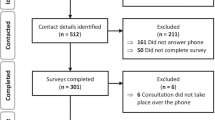Abstract
This paper will outline a series of three research studies meant to identify factors related to child mental health service usage and barriers to help seeking for urban minority children and their caretakers. In addition, this paper will describe the systematic development and evaluation of a telephone intervention strategy aimed towards increasing overall attendance at initial intake appointments at an urban child serving agency. The first study explores differences in demographic variables, for two groups of children (n=450), those that came to an initial intake interview and those that requested child mental health services, but failed to come to any scheduled appointments. The second study evaluates a telephone engagement intervention meant to increase initial attendance (n=54). Finally, the third study, more rigorously evaluates the impact of an intensive telephone intervention on initial attendance rates by randomly assigning families to the more focused telephone intervention or a “business as usual” telephone screening (n=108).
Similar content being viewed by others
References
Anderson, C. (1983).Mastering Resistance. New York: Guilford Press.
Acosta, F.X. (1980). Self described reasons for premature termination of psychotherapy by Mexican American, Black American and Anglo American patients.Psychological Reports, 47, 435–443.
Aponte, H.J., Zarski, J., Bixenstene, C. & Cibik, P. (1991). Home/community based services: A two-tier approach.American Journal of Orthopsychiatry, 61, 3, 403–408.
Armstrong, H.E., Ishiki, D., Heiman, J., Mundt, J. & Womack, W. (1984). Service utilization by Black and White clientele in an urban community mental health center: Revised assessment of an old problem.Community Mental Health Journal, 20, 4, 269–280.
Boyd-Franklin, N. (1993). Black families in Walsh, F. (Ed.).Normal Family Process. New York: Guilford Press.
Brandenburg, N.A., Friedman, R.M. & Silver, S.E. (1987). The epidemiology of childhood psychiatric disorders: Prevalence findings from recent studies.Journal of the American Academy of Child and Adolescent Psychiatry, 29, 76–83.
Bronfenbrenner, U. (1979).The ecology of human development: Experiments by nature and design. Cambridge, MA: Harvard University Press.
Bui, C.T. & Takeuchi, D.T. (1992). Ethnic minority adolescents and the use of community mental health care services.American Journal of Community Psychology, 20, 4, 403–417.
Burns, B.J., Angold, A., Magruder-Habib, Costello, E.J., Patrick, (1989).The Child and Adolescent Services Assessment. Developmental Epidemiology Program, Department of Psychiatry, Duke University.
Burns, B.J., Angold, A. & Costello, E.J. (1992). Measuring child, adolescent, and family service use: In L. Bickman & D. Rog (Eds.).Evaluating Mental Health Services for Children. San Francisco: Jossey-Bass, 17–30.
Cheung, F.K. & Snowden, L.R. (1989). Utilization of inpatient services by members of ethnic minority groups. Paper presented at Oklahoma Mental Health Research Institute Professional symposium, Tulsa, OK.
Cohen, P. & Hesselbart, C.S. (1993). Demographic factors in the use of children's mental health service.American Journal of Public health, 83, 1, 49–52.
Flaskerud, J.H. (1986). The effects of culture-compatible intervention on the utilization of mental health services by minority clients.Community Mental Health Journal, 22, 2, 127–140.
Gary, L.E. (1982). Attitudes toward human service organization: Perspectives from an urban Black community.Journal of Applied Behavioral Sciences, 21, 445–458.
Germain, C. (1980).The life model of social work practice. New York: Columbia University Press.
Guerra, N., Huessmann, R., Tolan, P.H., VanAcker, R. & Eron, L. (1990). Metropolitan Area Child Study. National Institute for Mental Health Research Proposal.
Hu, T., Snowden, L., Jerrell, J. & Nguyen, T. Ethnic populations in public mental health: Services choice and level of use.American Journal of Public health, 81, 11, 1429–1434.
Jacobs, S.E. (1979). “Our babies shall not die”: A community's response to medical neglect.Human Organization, 38, 120–133.
Kazdin, A. (1993). Premature termination from treatment among children referred for antisocial behavior.Journal of Clinical Child Psychology, 31, 8, 415–425.
Keefe, S.E., Padilla, A.M. & Carlos, M.L. (1979). The Mexican-American extended family as an emotional support system.Human Organization, 38, 144–152.
Landsverk, J., Madsen, J., Litrownik, A., Ganger, W. & Newton, R. (under review). Mental health problems of foster children in three California counties.
Muecke, M.A. (1983). In search of healers.Western Journal of Medicine, 139, 835–840.
Miller & Prinz, R. (1990). Enhancement of social learning family intervention for childhood conduct disorder.Psychological Bulletin, 108, 2, 291–307.
Minkler, M., Roe, K.M. & Price, M., (1992). The physical and emotional health of grandmothers raising grandchildren in the crack cocaine epidemic.The Gerontologist, 32, 752–761.
Mull, J.D., Wood, C.S., Gans, L.P. & Mull, D.S. (1989). Culture and “compliance” among leprosy patients in Pakistan.Social Science and Medicine, 29, 799–811.
Russell, M., Lang, M. & Brett, B. (1987). Reducing dropout rates through improved intake procedures.Social Casework, 421–425.
Schlosberg, S.B. & Kagan, R.M. (1988). Practice strategies for engaging chronic multiproblem families.Social Casework, 3–9.
Shivack, N. & Sullivan, T. (1991). Use of telephone prompts at an inner city outpatient clinic.Hospital and Community Psychiatry, 40, 8, 851–853.
Stanton, M.D. & Todd, T.C. (1981). Engaging “resistant” families in treatment.Family Process, 20, 3, 261–293.
Steffenson, M.S. & Colker, L. (1982). Intercultural misunderstandings about health care: Recall of descriptions of illness and treatment,Social Science Medicine, 16, 1249–1254.
Sue, S. (1977). Community mental health services to minority groups: Some optimism, some pessimism.American Psychologist, 32, 616–624.
Sue, S., Fujino, D.C., Hu, L. & Takeuchi, D.T. (1991). Community mental health services for ethnic minority groups: A test of the cultural responsiveness hypothesis.Journal of Consulting and Clinical Psychology, 59, 4, 533–540.
Sue, S. & Morishima, J.K. (1983).The mental health of Asian Americans. San Francisco: Jossey-Bass.
Szapocznik, J., Perez-Vidal, A., Brickman, A.L., Foote, F.H., Santesteban, D., Hervis, O., Kurtines, W.M. (1988). Engaging adolescent drug abusers and their families in treatment: A strategic structural systems approach.Journal of Consulting and Clinical Psychology, 56, 4, 552–557.
Tolan, P.H., McKay, M.M., Kohner, K. & Montaini, L. (1995). Engaging Inner City Families in Prevention Research. Manuscript submitted for publication.
Tuma, J.M. (1989). Mental health services for children.American Psychologist, 188–189.
Wahler, R. & Dumas, J. (1989). Attentional problems in dysfunctional mother-child interactions: An interbehavior model.Psychological Bulletin, 105, 116–130.
Wallen, J. Providing culturally appropriate mental health services for minorities. TheJournal of Mental Health Administration, 19, 3, 288–295.
Zahner, G., Pawelkiewicz, W., DeFrancesco, J.J. & Adnopoz, J. Children's mental health service needs and utilization patterns in an urban community: An epidemiological assessment.Journal of the American Academy of Child and Adolescent Psychiatry, 31, 5, 951–960.
Author information
Authors and Affiliations
Additional information
The authors wish to acknowledge the contribution of social work interns, Peggy Shelhorn and Shelly Derue. This work was supported by a grant from the National Institute of Mental Health (1R24MH54212-01).
Rights and permissions
About this article
Cite this article
McKay, M.M., McCadam, K. & Gonzales, J.J. Addressing the barriers to mental health services for inner city children and their caretakers. Community Ment Health J 32, 353–361 (1996). https://doi.org/10.1007/BF02249453
Issue Date:
DOI: https://doi.org/10.1007/BF02249453




